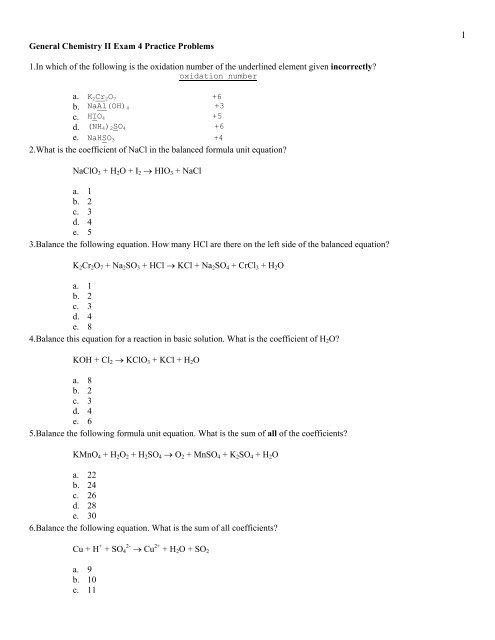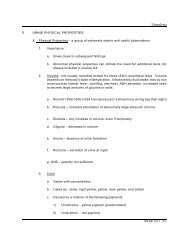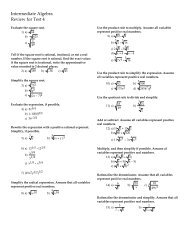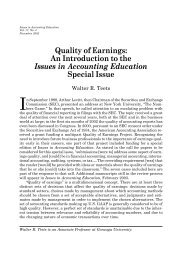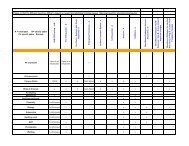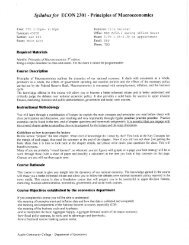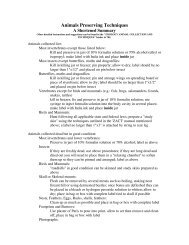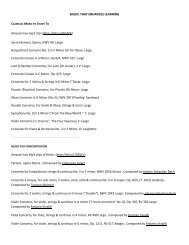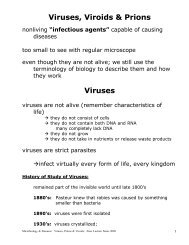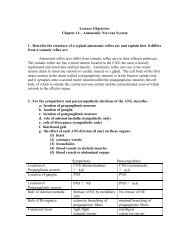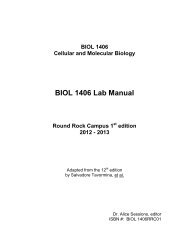General Chemistry II Exam 4 Practice Problems 1.In which of the ...
General Chemistry II Exam 4 Practice Problems 1.In which of the ...
General Chemistry II Exam 4 Practice Problems 1.In which of the ...
Create successful ePaper yourself
Turn your PDF publications into a flip-book with our unique Google optimized e-Paper software.
<strong>General</strong> <strong>Chemistry</strong> <strong>II</strong> <strong>Exam</strong> 4 <strong>Practice</strong> <strong>Problems</strong><br />
<strong>1.In</strong> <strong>which</strong> <strong>of</strong> <strong>the</strong> following is <strong>the</strong> oxidation number <strong>of</strong> <strong>the</strong> underlined element given incorrectly?<br />
oxidation number<br />
a. K2Cr2O7 +6<br />
b. NaAl(OH)4 +3<br />
c. HIO4 +5<br />
d. (NH4)2SO4 +6<br />
e. NaHSO3 +4<br />
2.What is <strong>the</strong> coefficient <strong>of</strong> NaCl in <strong>the</strong> balanced formula unit equation?<br />
NaClO3 + H2O + I2 → HIO3 + NaCl<br />
a. 1<br />
b. 2<br />
c. 3<br />
d. 4<br />
e. 5<br />
3.Balance <strong>the</strong> following equation. How many HCl are <strong>the</strong>re on <strong>the</strong> left side <strong>of</strong> <strong>the</strong> balanced equation?<br />
K2Cr2O7 + Na2SO3 + HCl → KCl + Na2SO4 + CrCl3 + H2O<br />
a. 1<br />
b. 2<br />
c. 3<br />
d. 4<br />
e. 8<br />
4.Balance this equation for a reaction in basic solution. What is <strong>the</strong> coefficient <strong>of</strong> H2O?<br />
KOH + Cl2 → KClO3 + KCl + H2O<br />
a. 8<br />
b. 2<br />
c. 3<br />
d. 4<br />
e. 6<br />
5.Balance <strong>the</strong> following formula unit equation. What is <strong>the</strong> sum <strong>of</strong> all <strong>of</strong> <strong>the</strong> coefficients?<br />
KMnO4 + H2O2 + H2SO4 → O2 + MnSO4 + K2SO4 + H2O<br />
a. 22<br />
b. 24<br />
c. 26<br />
d. 28<br />
e. 30<br />
6.Balance <strong>the</strong> following equation. What is <strong>the</strong> sum <strong>of</strong> all coefficients?<br />
Cu + H + + SO4 2- → Cu 2+ + H2O + SO2<br />
a. 9<br />
b. 10<br />
c. 11<br />
1
d. 12<br />
e. 13<br />
7.Balance <strong>the</strong> following net ionic equation. What is <strong>the</strong> sum <strong>of</strong> <strong>the</strong> coefficients?<br />
MnO4 - + I - + H2O → I2 + MnO2 + OH -<br />
a. 21<br />
b. 23<br />
c. 25<br />
d. 27<br />
e. 29<br />
____ 8. Balance <strong>the</strong> following net ionic equation. Use H + ra<strong>the</strong>r than H3O + . What is <strong>the</strong> sum <strong>of</strong> <strong>the</strong> coefficients?<br />
H2O2 + Fe 2+ → Fe 3+ (in acidic solution)<br />
a. 13<br />
b. 15<br />
c. 7<br />
d. 9<br />
e. 11<br />
9.What volume <strong>of</strong> 0.0100 M KMnO4 solution is required to oxidize 42.5 mL <strong>of</strong> 0.0100 M FeSO4 sulfuric acid solution?<br />
MnO4 - + 8H + + 5Fe 2+ → Mn 2+ + 5Fe 3+ + 4H2O<br />
a. 16.0 mL<br />
b. 8.5 mL<br />
c. 21.3 mL<br />
d. 80.0 mL<br />
e. 31.9 mL<br />
10.What is <strong>the</strong> molarity <strong>of</strong> a solution <strong>of</strong> FeSO4 if 25.06 mL <strong>of</strong> it reacts with 38.19 mL <strong>of</strong> 0.1214 M KMnO4?<br />
MnO4 - + 8H + + 5Fe 2+ → Mn 2+ + 5Fe 3+ + 4H2O<br />
a. 0.1854 M<br />
b. 0.3992 M<br />
c. 0.07985 M<br />
d. 0.4267 M<br />
e. 0.9250 M<br />
11.What volume <strong>of</strong> 0.1084 M (COOH)2 solution would be required to react with 0.1268 grams <strong>of</strong> KMnO4?<br />
(COOH)2 + MnO4 - + H + → CO2 + Mn 2+ + H2O (unbalanced)<br />
a. 18.50 mL<br />
b. 37.02 mL<br />
c. 55.51 mL<br />
d. 24.02 mL<br />
e. 66.61 mL<br />
12.When household ammonia is mixed with bleach, NaOCl, toxic chlorine gas and hydrazine, N2H4 is produced. What<br />
volume <strong>of</strong> 0.75 M NH3 would react with 100 mL <strong>of</strong> 0.35 M NaOCl?<br />
NH3 + OCl - → Cl2 + N2H4 (unbalanced)<br />
a. 23.5 Ml<br />
2
3<br />
b. 100 mL<br />
c. 94 mL<br />
d. 26 mL<br />
e. 47 mL<br />
13.A 50.0-mL sample <strong>of</strong> K2Cr2O7 solution oxidizes 1.500 g <strong>of</strong> Na2SO3 to Na2SO4. Cr2(SO4)3 is also produced. What is <strong>the</strong><br />
molarity <strong>of</strong> <strong>the</strong> K2Cr2O7 solution?<br />
a. 0.0794 M<br />
b. 0.476 M<br />
c. 2.96 M<br />
d. 0.0952 M<br />
e. 0.0158 M<br />
14.In any electrochemical cell, <strong>the</strong> anode is always .<br />
a. <strong>the</strong> positive electrode<br />
b. <strong>the</strong> negative electrode<br />
c. <strong>the</strong> electrode at <strong>which</strong> some species gains electrons<br />
d. <strong>the</strong> electrode at <strong>which</strong> some species loses electrons<br />
e. <strong>the</strong> electrode at <strong>which</strong> reduction occurs<br />
15.During <strong>the</strong> electrolysis <strong>of</strong> molten sodium bromide, sodium ions move .<br />
a. to <strong>the</strong> anode, <strong>which</strong> is positively charged<br />
b. to <strong>the</strong> anode, <strong>which</strong> is negatively charged<br />
c. to <strong>the</strong> cathode, <strong>which</strong> is positively charged<br />
d. to <strong>the</strong> cathode, <strong>which</strong> is negatively charged<br />
e. through <strong>the</strong> wire to <strong>the</strong> battery<br />
16.The electrolysis <strong>of</strong> an aqueous sodium chloride solution using inert electrodes produces gaseous chlorine at one<br />
electrode. At <strong>the</strong> o<strong>the</strong>r electrode gaseous hydrogen is produced, and <strong>the</strong> solution becomes basic around <strong>the</strong><br />
electrode. Which <strong>of</strong> <strong>the</strong> following is <strong>the</strong> equation for <strong>the</strong> cathode half-reaction in this electrolytic cell?<br />
a. 2Cl - → Cl2 + 2e -<br />
b. 2H2O + 2e - → H2 + 2OH -<br />
c. Cl2 + 2e - → 2Cl -<br />
d. H2 + 2OH - → 2H2O + 2e -<br />
e. none <strong>of</strong> <strong>the</strong>se<br />
17.How many coulombs <strong>of</strong> charge pass through a cell if 2.40 amperes <strong>of</strong> current are passed through <strong>the</strong> cell for 85.0<br />
minutes?<br />
a. 2.04 × 10 2 C<br />
b. 1.33 × 10 -1 C<br />
c. 1.22 × 10 4 C<br />
d. 2.12 × 10 3 C<br />
e. 3.40 C<br />
18.How many moles <strong>of</strong> chromium would be electroplated by passing a current <strong>of</strong> 5.2 amperes through a solution <strong>of</strong><br />
Cr2(SO4)3 for 45.0 minutes?<br />
a. 0.048 mol<br />
b. 2.9 mol<br />
c. 0.15 mol<br />
d. 6.9 mol<br />
e. 0.073 mol<br />
19.How many grams <strong>of</strong> metallic nickel can be produced by <strong>the</strong> electrolysis <strong>of</strong> aqueous nickel(<strong>II</strong>) chloride, NiCl2, with a<br />
0.350 ampere current for 5.00 hours?<br />
a. 1.19 g<br />
b. 1.92 g<br />
c. 7.66 g<br />
d. 2.76 g<br />
e. 3.83 g
4<br />
20.How long would a constant current <strong>of</strong> 4.5 amperes be required to flow in order to plate out 15 g <strong>of</strong> chromium from a<br />
chromium(<strong>II</strong>I) sulfate solution?<br />
a. 268 hr<br />
b. 309 hr<br />
c. 5.15 hr<br />
d. 23.2 hr<br />
e. 1.72 hr<br />
21.Molten AlCl3 is electrolyzed for 5.0 hours with a current <strong>of</strong> 0.40 ampere. Metallic aluminum is produced at one<br />
electrode and chlorine gas, Cl2, is produced at <strong>the</strong> o<strong>the</strong>r. How many liters <strong>of</strong> Cl2 measured at STP are<br />
produced at <strong>the</strong> o<strong>the</strong>r electrode?<br />
a. 0.56 L<br />
b. 0.63 L<br />
c. 0.84 L<br />
d. 0.98 L<br />
e. 1.02 L<br />
22.Calculate <strong>the</strong> quantity <strong>of</strong> charge necessary to produce 10 liters <strong>of</strong> H2(g) at STP from <strong>the</strong> electrolysis <strong>of</strong> water.<br />
a. 8.6 × 10 4 coulombs<br />
b. 3.7 × 10 4 coulombs<br />
c. 1.7 × 10 4 coulombs<br />
d. 5.3 × 10 4 coulombs<br />
e. 4.8 × 10 4 coulombs<br />
23.Oxidation occurs at <strong>the</strong> in a voltaic cell and oxidation occurs at <strong>the</strong> in an electrolytic cell.<br />
a. anode, anode<br />
b. cathode, cathode<br />
c. anode, cathode<br />
d. cathode, anode<br />
e. anode, salt bridge<br />
24.A current <strong>of</strong> 15.0 amperes electroplated 50.0 g <strong>of</strong> hafnium (Hf) metal from an aqueous solution in 2.00 hours. What is<br />
<strong>the</strong> oxidation number (charge) <strong>of</strong> hafnium in <strong>the</strong> solution?<br />
a. +1 d. +4<br />
b. +2 e. +5<br />
c. +3<br />
25.A voltaic cell is constructed by immersing a strip <strong>of</strong> copper metal in 1.0 M CuSO4 solution and a strip <strong>of</strong> aluminum in<br />
0.50 M Al2(SO4)3 solution. A wire and a salt bridge complete <strong>the</strong> circuit. The aluminum strip loses mass, and<br />
<strong>the</strong> concentration <strong>of</strong> aluminum ions in <strong>the</strong> solution increases. The copper electrode gains mass, and <strong>the</strong><br />
concentration <strong>of</strong> copper ions decreases. Which <strong>of</strong> <strong>the</strong> following are applicable to <strong>the</strong> copper electrode?<br />
I. The anode<br />
<strong>II</strong>. The cathode<br />
<strong>II</strong>I. The positive electrode<br />
IV. The electrode at <strong>which</strong> electrons are produced<br />
V. The negative electrode<br />
VI. The electrode at <strong>which</strong> electrons are used up<br />
a. I, <strong>II</strong>I, and V<br />
b. I, IV, and V<br />
c. <strong>II</strong>, IV, and V<br />
d. <strong>II</strong>, <strong>II</strong>I, and VI<br />
e. None <strong>of</strong> <strong>the</strong> first four responses contains all <strong>the</strong> correct choices and no o<strong>the</strong>rs.<br />
26.Which <strong>of</strong> <strong>the</strong> following species is <strong>the</strong> strongest oxidizing agent?<br />
a. Sn 2+<br />
b. Sn 4+<br />
c. Br2
d. Br -<br />
e. Li<br />
27.Which one <strong>of</strong> <strong>the</strong> following statements about <strong>the</strong> half-cell processes is true for <strong>the</strong> cell,<br />
Cd|Cd 2+ (1 M)||Cu 2+ (1 M)|Cu?<br />
a. Cu 2+ is reduced at <strong>the</strong> anode.<br />
b. Cu 2+ is reduced at <strong>the</strong> cathode.<br />
c. Cd 2+ is reduced at <strong>the</strong> anode.<br />
d. Cd 2+ is reduced at <strong>the</strong> cathode.<br />
e. The spontaneous reaction that occurs in this cell is not a redox reaction.<br />
28.Which one <strong>of</strong> <strong>the</strong> following reactions is spontaneous (in <strong>the</strong> direction given) under standard electrochemical<br />
conditions?<br />
a. Pb 2+ + 2I - → Pb + I2<br />
b. Cu 2+ + Fe → Cu + Fe 2+<br />
c. 2Au + Pt 2+ → 2Au + + Pt<br />
d. Mg 2+ + 2Br - → Mg + Br2<br />
e. 2Hg + 2Cl - + 2H + → Hg2Cl2 + H2<br />
29.What is <strong>the</strong> cell potential for a cell constructed by immersing a strip <strong>of</strong> manganese in a 1. M MnSO4 solution and a<br />
strip <strong>of</strong> iron in a 1.0 M FeSO4 solution and completing <strong>the</strong> circuit by a wire and a salt bridge?<br />
a. -1.62 V<br />
b. +1.62 V<br />
c. -0.74 V<br />
d. +0.74 V<br />
e. +1.21 V<br />
30.A voltaic cell is constructed by immersing a strip <strong>of</strong> copper metal in 1.0 M CuSO4 solution and a strip <strong>of</strong> aluminum in<br />
0.50 M Al2(SO4)3 solution. A wire and a salt bridge complete <strong>the</strong> circuit. The aluminum strip loses mass, and<br />
<strong>the</strong> concentration <strong>of</strong> aluminum ions in <strong>the</strong> solution increases. The copper electrode gains mass, and <strong>the</strong><br />
concentration <strong>of</strong> copper ions decreases. What is <strong>the</strong> cell potential?<br />
a. +1.28 V<br />
b. +2.00 V<br />
c. +2.34 V<br />
d. +2.50 V<br />
e. +3.66 V<br />
31.Given <strong>the</strong> following standard electrode potentials:<br />
Half-Reaction E 0<br />
O2(g) + 4H + + 4e - → 2H2O +1.23 V<br />
2CO2(g) + 2H + + 2e - → (COOH)2<br />
-0.49 V<br />
Which response contains all <strong>the</strong> true statements and no o<strong>the</strong>rs? (Assume all species are present under standard<br />
electrochemical conditions.)<br />
I. H2O will spontaneously oxidize (COOH)2 to form CO2.<br />
<strong>II</strong>. O2(g) will spontaneously oxidize (COOH)2 to form CO2.<br />
<strong>II</strong>I. (COOH)2 will spontaneously reduce O2(g) to form H2O.<br />
IV. H + will spontaneously reduce (COOH)2 to form CO2.<br />
V. CO2 will spontaneously oxidize H2O to form O2(g).<br />
a. <strong>II</strong>, IV, and V<br />
b. I, <strong>II</strong>I, and IV<br />
c. <strong>II</strong> and <strong>II</strong>I<br />
d. I and IV<br />
5
e. <strong>II</strong>I and V<br />
32.Which response lists all <strong>of</strong> <strong>the</strong> following reactions that are spontaneous?<br />
I. F2(g) + SO2 + 2H2O → 2F - + SO4 2- + 4H +<br />
<strong>II</strong>. Cl2(g) + Sn 2+ → 2Cl - + Sn 4+<br />
<strong>II</strong>I. 2NO(g) + 4H2O + 3Br2(l) → 6Br - + 2NO3 - + 8H +<br />
IV. H2O2 + 2H + + 2I - → 2H2O(l) + I2(s)<br />
a. I and <strong>II</strong>I<br />
b. <strong>II</strong> and IV<br />
c. I, <strong>II</strong>, and <strong>II</strong>I<br />
d. <strong>II</strong>, <strong>II</strong>I, and IV<br />
e. I, <strong>II</strong>, <strong>II</strong>I, and IV<br />
33.Calculate <strong>the</strong> reduction potential <strong>of</strong> <strong>the</strong> Zn 2+ /Zn electrode when [Zn 2+ ] = 1.0 × 10 -8 M.<br />
a. -0.73 V<br />
b. -0.75 V<br />
c. -0.76 V<br />
d. -0.77 V<br />
e. -1.00 V<br />
34.A cell is constructed by immersing a strip <strong>of</strong> silver in 0.10 M AgNO3 solution and a strip <strong>of</strong> lead in 1.0 M Pb(NO3)2<br />
solution. A wire and salt bridge complete <strong>the</strong> cell. What is <strong>the</strong> potential <strong>of</strong> <strong>the</strong> silver electrode in <strong>the</strong> cell?<br />
a. 0.74 V<br />
b. 0.80 V<br />
c. 0.83 V<br />
d. 0.86 V<br />
e. 0.88 V<br />
35.What is <strong>the</strong> cell potential for <strong>the</strong> reaction below if [Cr2O7 2- ] = 0.0010 M, [Cr 3+ ] = 0.150 M, [H + ] = 1.00 M, and [Br - ] =<br />
0.450 M, and some bromine is also present initially?<br />
Cr2O7 2- + 14H + + 6Br - → 3Br2(l) + 2Cr 3+ + 7H2O(l)<br />
a. +0.28 V<br />
b. +0.31 V<br />
c. 0.22 V<br />
d. +0.24 V<br />
e. +0.29 V<br />
36.Calculate Ecell for <strong>the</strong> following voltaic cell.<br />
Ag|Ag + (1.0 × 10 -5 M)||Au 3+ (1.0 × 10 -1 M)|Au<br />
a. +0.78 V<br />
b. +0.46 V<br />
c. +0.88 V<br />
d. +0.98 V<br />
e. +2.58 V<br />
37.What is ∆G 0 at 25°C for <strong>the</strong> reaction below? (F = 96,500 J/V•mol e - )<br />
Cu 2+ + Cd → Cu + Cd 2+<br />
a. -71.1 kJ<br />
b. -143 kJ<br />
c. 597 kJ<br />
6
7<br />
d. 193 kJ<br />
e. +71.1 kJ<br />
38.What product is formed at <strong>the</strong> anode when molten sodium chloride, NaCl, is electrolyzed using a Downs cell?<br />
a. O2<br />
b. Cl2<br />
c. NaOH<br />
d. H2<br />
e. Na metal<br />
39.How long would a constant current <strong>of</strong> 18.0 amperes be required to flow in order for 9000. coulombs <strong>of</strong> charge to pass<br />
through a cell?<br />
a. 200. s<br />
b. 500. s<br />
c. 0.002 s<br />
d. 50. s<br />
e. 1.6 × 10 5 s<br />
40.Current is passed through a cell where <strong>the</strong> half-reaction that occurs at <strong>the</strong> cathode is 5e - + MnO4 - + 8H + → Mn 2+ +<br />
4H2O. All <strong>the</strong> MnO4 - ions present in 25.0 mL <strong>of</strong> solution have been reduced after a current <strong>of</strong> 0.600 ampere<br />
has passed for 844 seconds. What was <strong>the</strong> original concentration <strong>of</strong> MnO4 - ions?<br />
a. 7.10 × 10 -3 M<br />
b. 1.02 × 10 -1 M<br />
c. 0.21 M<br />
d. 1.47 M<br />
e. 4.20 × 10 -2 M<br />
41.A zinc bar weighing 3.0 kg is attached to a buried iron pipe to protect <strong>the</strong> pipe from corrosion. An average current <strong>of</strong><br />
0.020 A flows between <strong>the</strong> bar and <strong>the</strong> pipe. How many years will be required for <strong>the</strong> zinc bar to be entirely<br />
consumed? (1 yr = 3.16 × 10 7 s)<br />
a. 600yr<br />
b. 14.0 yr<br />
c. 5.99 yr<br />
d. 7.00 yr<br />
e. 6.66 yr<br />
42.Calculate ∆G 0 for <strong>the</strong> following reaction from its Evalue.<br />
F = 96,500 J/V•mol e - )<br />
3Hg2Cl2 + 2Cr → 2Cr 3+ + 6Hg + 6Cl -<br />
a. -1.12 × 10 3 kJ<br />
b. -585 kJ<br />
c. -361 kJ<br />
d. 1.62 × 10 3 kJ<br />
e. -1.78 × 10 3 kJ
<strong>General</strong> <strong>Chemistry</strong> <strong>II</strong> <strong>Exam</strong> 4 <strong>Practice</strong> <strong>Problems</strong><br />
Answer Section<br />
MULTIPLE CHOICE<br />
1. ANS: C PTS: 1 TOP: Balancing Redox Reactions<br />
2. ANS: E PTS: 1 TOP: Balancing Redox Reactions<br />
3. ANS: E PTS: 1 TOP: Balancing Redox Reactions<br />
4. ANS: C PTS: 1 TOP: Balancing Redox Reactions<br />
5. ANS: C PTS: 1 TOP: Balancing Redox Reactions<br />
6. ANS: B PTS: 1 TOP: Balancing Redox Reactions<br />
7. ANS: C PTS: 1 TOP: Balancing Redox Reactions<br />
8. ANS: D PTS: 1 TOP: Balancing Redox Reactions<br />
9. ANS: B PTS: 1 TOP: Stoichiometry <strong>of</strong> Redox Reactions<br />
10. ANS: E PTS: 1 TOP: Stoichiometry <strong>of</strong> Redox Reactions<br />
11. ANS: A PTS: 1 TOP: Stoichiometry <strong>of</strong> Redox Reactions<br />
12. ANS: E PTS: 1 TOP: Stoichiometry <strong>of</strong> Redox Reactions<br />
13. ANS: A PTS: 1 TOP: Stoichiometry <strong>of</strong> Redox Reactions<br />
14. ANS: D PTS: 1 TOP: Electrodes<br />
15. ANS: D PTS: 1 TOP: The Electrolysis <strong>of</strong> Molten Salts<br />
16. ANS: B PTS: 1 TOP: The Electrolysis <strong>of</strong> Aqueous Salt Solutions<br />
17. ANS: C PTS: 1 TOP: Faraday's Law <strong>of</strong> Electrolysis<br />
18. ANS: A PTS: 1 TOP: Faraday's Law <strong>of</strong> Electrolysis<br />
19. ANS: B PTS: 1 TOP: Faraday's Law <strong>of</strong> Electrolysis<br />
20. ANS: C PTS: 1 TOP: Faraday's Law <strong>of</strong> Electrolysis<br />
21. ANS: C PTS: 1 TOP: Faraday's Law <strong>of</strong> Electrolysis<br />
22. ANS: A PTS: 1 TOP: Faraday's Law <strong>of</strong> Electrolysis<br />
23. ANS: A PTS: 1 TOP: Voltaic or Galvanic Cells<br />
24. ANS: D PTS: 1<br />
25. ANS: D<br />
A table <strong>of</strong> standard electrode potentials may be necessary for this question.<br />
PTS: 1 TOP: Voltaic or Galvanic Cells<br />
26. ANS: C<br />
A table <strong>of</strong> standard electrode potentials may be necessary for this question.<br />
PTS: 1 TOP: Standard Electrode Potentials<br />
27. ANS: B<br />
A table <strong>of</strong> standard electrode potentials may be necessary for this question.<br />
PTS: 1 TOP: Uses <strong>of</strong> Standard Electrode Potentials<br />
28. ANS: B<br />
A table <strong>of</strong> standard electrode potentials may be necessary for this question.<br />
PTS: 1 TOP: Uses <strong>of</strong> Standard Electrode Potentials<br />
29. ANS: D<br />
A table <strong>of</strong> standard electrode potentials may be necessary for this question.<br />
PTS: 1 TOP: Uses <strong>of</strong> Standard Electrode Potentials<br />
30. ANS: B<br />
8
A table <strong>of</strong> standard electrode potentials may be necessary for this question.<br />
PTS: 1 TOP: Uses <strong>of</strong> Standard Electrode Potentials<br />
31. ANS: C<br />
A table <strong>of</strong> standard electrode potentials may be necessary for this question.<br />
PTS: 1 TOP: Standard Electrode Potentials for O<strong>the</strong>r Half-Reactions<br />
32. ANS: E<br />
A table <strong>of</strong> standard electrode potentials may be necessary for this question.<br />
PTS: 1 TOP: Standard Electrode Potentials for O<strong>the</strong>r Half-Reactions<br />
33. ANS: E<br />
A table <strong>of</strong> standard electrode potentials may be necessary for this question.<br />
PTS: 1 TOP: The Nernst Equation<br />
34. ANS: A<br />
A table <strong>of</strong> standard electrode potentials may be necessary for this question.<br />
PTS: 1 TOP: The Nernst Equation<br />
35. ANS: C<br />
A table <strong>of</strong> standard electrode potentials may be necessary for this question.<br />
PTS: 1 TOP: The Nernst Equation<br />
36. ANS: D<br />
A table <strong>of</strong> standard electrode potentials may be necessary for this question.<br />
PTS: 1 TOP: The Nernst Equation<br />
37. ANS: B<br />
A table <strong>of</strong> standard electrode potentials may be necessary for this question.<br />
PTS: 1 TOP: The Relationship <strong>of</strong> E... to Delta G0 and K<br />
38. ANS: B PTS: 1 TOP: The Electrolysis <strong>of</strong> Molten Salts<br />
39. ANS: B PTS: 1 TOP: Faraday's Law <strong>of</strong> Electrolysis<br />
40. ANS: E PTS: 1 TOP: Faraday's Law <strong>of</strong> Electrolysis<br />
41. ANS: B<br />
A table <strong>of</strong> standard electrode potentials may be necessary for this question.<br />
PTS: 1 TOP: Corrosion Protection<br />
42. ANS: B PTS: 1 TOP: The Relationship <strong>of</strong> E... to Delta G0 and K<br />
9


